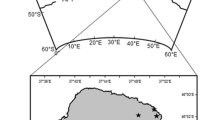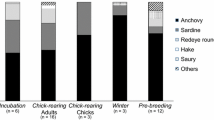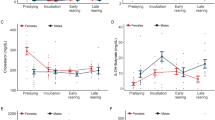Abstract
Nutrients that are limited in availability, such as carotenoids, are potentially involved in trade-offs between homeostasis and reproduction. Despite their importance, factors that affect the capacity of female birds to meet their carotenoid requirements are poorly understood. We used δ15N stable isotope analysis to relate foraging behavior to yolk carotenoid deposition in two seabirds, Cassin’s auklet (Ptychoramphus aleuticus) and rhinoceros auklet (Cerorhinca monocerata), during each of five years. As expected from their narrower trophic range, Cassin’s auklets produced yolks with fewer carotenoid types than did rhinoceros auklets (one vs. three). Cassin’s auklets also fed on a lower trophic level diet richer in carotenoids, yet had lower total yolk carotenoid levels, which suggests a role for species-specific adaptations for carotenoid uptake and utilization. Within both species, lower trophic-level feeding was linked to higher yolk carotenoid levels, but through different mechanisms. In Cassin’s auklets, it was due to a population-wide response to environmental variation: in warm-water years, all females fed at a low trophic level and produced carotenoid-rich yolks. In rhinoceros auklets, it was due to individual differences similarly expressed in all years: females fed across a wide trophic range, and those that fed at a low trophic level produced carotenoid-rich yolks. Rhinoceros auklets bred more successfully in years when their yolks were rich in carotenoids, probably due to a correlated response to stronger marine primary production. Our results are novel because they link avian yolk carotenoid deposition to behavioral and environmental variations.



Similar content being viewed by others
References
Abraham CL, Sydeman WJ (2004) Ocean climate, euphausiids and auklet nesting: inter-annual trends and variation in phenology, diet and growth of a planktivorous seabird, Ptychoramphus aleuticus. Mar Ecol Prog Ser 274:235–250
Abraham CL, Sydeman WJ (2006) Prey-switching by Cassin’s auklet Ptychoramphus aleuticus reveals seasonal climate-related cycles of Euphausia pacifica and Thysanoessa spinifera. Mar Ecol Prog Ser 313:271–283
Addison B, Benowitz-Fredericks ZM, Hipfner JM, Kitaysky AS (2008) Are yolk androgens adjusted to environmental conditions? A test in two seabirds that lay single-egg clutches. Gen Comp Endocrinol 158:5–9
Biard C, Surai PF, Møller AP (2005) Effects of carotenoid availability during laying on reproduction in the blue tit. Oecologia 144:32–44
Biard C, Surai PF, Møller AP (2006) Carotenoid availability in diet and phenotype of blue and great tit nestlings. J Exp Biol 209:1004–1015
Bize P, Devevey G, Monaghan P, Doligez B, Christe P (2008) Fecundity and survival in relation to resistance to oxidative stress in a free-living bird. Ecology 89:2584–2593
Blount JD, Houston DC, Møller AP (2000) Why egg yolk is yellow. Trends Ecol Evol 15:47–49
Blount JD, Surai PF, Houston DC, Møller AP (2002a) Patterns of yolk enrichment with dietary carotenoids in gulls: the roles of pigment acquisition and utilization. Funct Ecol 16:445–453
Blount JD, Surai PF, Nager RG, Houston DC, Møller AP, Trewby ML, Kennedy MW (2002b) Carotenoids and egg quality in the lesser black-backed gull Larus fuscus: a supplemental feeding study of maternal effects. Proc R Soc Lond B 269:29–36
Blount JD, Houston DC, Surai PF, Møller AP (2004) Egg-laying capacity is limited by carotenoid pigment availability in wild gulls Larus fuscus. Proc R Soc Lond B 271:S79–S81
Bortolotti GR, Negro JJ, Surai PF, Prieto P (2003) Carotenoids in eggs and plasma of red-legged partridges: effects of diet and reproductive output. Physiol Biochem Zool 76:367–374
Cassey P, Ewen JG, Boulton RL, Blackburn TM, Møller AP, Biard C, Olson V, Karadaş F (2005) Egg carotenoids in passerine birds introduced to New Zealand: relations to ecological factors, integument coloration and phylogeny. Funct Ecol 19:719–726
Cohen AA, McGraw KJ, Wiersma P, Williams JB, Robinson WD, Robinson TR, Brawn JD, Ricklefs RE (2008) Interspecific associations between circulating antioxidant levels and life-history variation in birds. Am Nat 172:178–193
Davies WE, Hipfner JM, Hobson KA, Ydenberg RC (2009) Seabird seasonal trophodynamics: isotopic patterns in a community of Pacific alcids. Mar Ecol Prog Ser 382:211–219
DeForest LN, Gaston AJ (1996) The effect of age on timing of breeding and reproductive success in the thick-billed Murre. Ecology 77:1501–1511
Deniro MJ, Epstein S (1978) Influence of diet on distribution of carbon isotopes in animals. Geochim Cosmochim Acta 42:495–506
Friesen VL, Baker AJ, Piatt JF (1996) Phylogenetic relationships within the Alcidae (Charadriiformes: Aves) inferred from total molecular evidence. Mol Biol Evol 13:359–367
Hargitai R, Matus Z, Hegyi G, Michl G, Tóth G, Török J (2006) Antioxidants in the egg yolk of a wild passerine: differences between breeding seasons. Comp Biochem Physiol B 143:145–152
Hedd A, Ryder JL, Cowen LL, Bertram DF (2002) Inter-annual variation in the diet, provisioning and growth of Cassin’s auklet at Triangle Island, British Columbia: responses to variation in ocean climate. Mar Ecol Prog Ser 229:221–232
Hedd A, Bertram DF, Ryder JL, Jones IL (2006) Effects of interdecadal climate variability on marine trophic interactions: rhinoceros auklets and their fish prey. Mar Ecol Prog Ser 309:263–278
Hipfner JM (2008) Matches and mismatches: ocean climate, prey phenology and breeding success in a zooplanktivorous seabird. Mar Ecol Prog Ser 368:295–304
Hipfner JM (2009) Euphausiids in the diet of a North Pacific seabird: annual and seasonal variation and the role of ocean climate. Mar Ecol Prog Ser 390:277–289
Hipfner JM, Charleton K, Davies WE (2004) Rates and consequences of relaying in Cassin’s auklets Ptychoramphus aleuticus and rhinoceros auklets Cerorhinca monocerata breeding in a seasonal environment. J Avian Biol 35:224–236
Hipfner JM, McFarlane-Tranquilla LA, Addison B (2008) Do marine birds use environmental cues to optimize egg production? An experimental test based on relaying propensity. J Avian Biol 39:611–618
Hipfner JM, McFarlane-Tranquilla LA, Addison B (2010) Experimental evidence that both timing and parental quality affect breeding success in a zooplanktivorous seabird. Auk 127:195–203
Hudon J, Grether GF, Millie DF (2003) Marginal differentiation between the sexual and general carotenoid pigmentation of guppies (Poecilia reticulata) and a possible visual explanation. Physiol Biochem Zool 76:776–790
Ito M, Minami H, Tanaka Y, Watanuki Y (2009) Seasonal and inter-annual oceanographic changes induce diet switching in a piscivorous seabird. Mar Ecol Prog Ser 393:273–284
Lack D (1968) Ecological adaptations for breeding in birds. Methuen, London
Mackas DL, Batten S, Trudel M (2007) Effects on zooplankton of a warmer ocean: recent evidence from the Northeast Pacific. Prog Oceanogr 75:223–252
Matsuno T (2001) Aquatic animal carotenoids. Fish Sci 67:771–783
McGraw KJ, Gregory AJ (2004) Carotenoid pigments in male American goldfinches: what is the optimal biochemical strategy for becoming colourful? Biol J Linn Soc 83:273–280
McGraw KJ, Klasing KC (2006) Carotenoids, immunity, and integumentary coloration in red junglefowl (Gallus gallus). Auk 123:1161–1171
McGraw KJ, Nolan PM, Crino OL (2006) Carotenoid accumulation strategies for becoming a colourful house finch: analyses of plasma and liver pigments in wild moulting birds. Funct Ecol 20:678–688
Monaghan P, Metcalfe NB, Torres R (2008) Oxidative stress as a mediator of life-history trade-offs: mechanisms, measurements and interpretations. Ecol Lett 11:1238–1251
Olson VA (2006) Estimating nutrient intake in comparative studies of animals: an example using dietary carotenoid content in birds. Oikos 112:620–628
Olson VA, Owens IPF (2005) Interspecific variation in the use of carotenoid-based coloration in birds: diet, life history and phylogeny. J Evol Biol 18:1534–1546
Peterson BJ, Fry B (1987) Stable isotopes in ecosystem studies. Ann Rev Ecol Syst 18:293–320
Piatt JF, Sydeman WJ, Wiese F (2007) Introduction: a modern role for seabirds as indicators. Mar Ecol Prog Ser 352:199–204
Pyle P, Sydeman WJ, Hester M (2001) Effects of age, breeding experience, mate fidelity and site fidelity on breeding performance in a declining population of Cassin’s auklets. J Anim Ecol 70:1088–1097
Ricklefs RE, Wikelski M (2002) The physiology/life-history nexus. Trends Ecol Evol 17:462–468
Rodway MS, Lemon MJF, Summers KR (1990) British Columbia seabird colony inventory: Scott Islands. Environment Canada, Vancouver
Royle NJ, Surai PF, McCartney RJ, Speake BK (1999) Parental investment and egg yolk lipid composition in gulls. Funct Ecol 13:298–306
Royle NJ, Surai PF, Hartley IR (2001) Maternally derived androgens and antioxidants in bird eggs: complementary but opposing effects? Behav Ecol 12:381–385
Safran RJ, Pilz KM, McGraw KJ, Correa SM, Schwabl H (2008) Are yolk androgens and carotenoids in barn swallow eggs related to parental quality? Behav Ecol Sociobiol 62:427–438
Saino N, Ferrari R, Romano M, Martinelli R, Møller AP (2003) Experimental manipulation of egg carotenoids affects immunity of barn swallow nestlings. Proc R Soc Lond B 270:2485–2489
Sorenson MC, Hipfner JM, Kyser TK, Norris DR (2009) Carry-over effects in a Pacific seabird: stable isotope evidence that pre-breeding diet quality influences reproductive success. J Anim Ecol 78:460–467
Stearns SC (1992) The evolution of life histories. Oxford University Press, Oxford
Tella JL, Figuerola J, Negro JJ, Blanco G, Rodriguez-Estrella R, Forero MG, Blázquez MC, Green AJ, Hiraldo F (2004) Ecological, morphological and phylogenetic correlates of interspecific variation in plasma carotenoid concentration in birds. J Evol Biol 17:156–164
Thayer JA, Sydeman WJ (2006) Spatio-temporal variability in prey harvest and reproductive ecology of a piscivorous seabird, Cerorhinca monocerata, in an upwelling system. Mar Ecol Prog Ser 329:253–265
Thayer JA, Bertram DF, Hatch SA, Hipfner JM, Slater L, Sydeman WJ, Watanuki Y (2008) Forage fish of the Pacific Rim as revealed by diet of a piscivorous seabird: synchrony and relationships with sea surface temperature. Can J Fish Aquat Sci 65:1610–1622
Tyndale ST, Letcher RL, Heath JW, Heath DW (2008) Why are salmon eggs red? Egg carotenoids and early life survival of chinook salmon (Onchorhynchus tshawtscha). Evol Ecol Res 10:1187–1199
Verhulst S, Nilsson JA (2008) The timing of birds’ breeding seasons: a review of experiments that manipulated timing of breeding. Philos Trans R Soc B 363:399–410
Volker O (1938) The dependence of lipochrome formation in birds on plant carotenoids. In: Proceedings of 8th international ornithological congress, Oxford, UK, 2–6 July 1934, pp 425–426
Ware DM, Thomson RE (2005) Bottom-up ecosystem trophic dynamics determine fish production in the Northeast Pacific. Science 308:1280–1284
Wolf SG, Sydeman WJ, Hipfner JM, Abraham CL, Tershy B, Croll DA (2009) Range-wide reproductive consequences of ocean climate variability for the seabird Cassin’s Auklet. Ecology 90:742–753
Zera AJ, Harshman LG, Williams TD (2007) Evolutionary endocrinology: the developing synthesis between endocrinology and evolutionary genetics. Ann Rev Ecol Evol Syst 38:793–817
Acknowledgments
We thank the many field workers whose tireless efforts made this research possible. We were financially supported by the Nestucca Oil Spill Trust Fund, the Centre for Wildlife Ecology, the World Wildlife Fund Canada, and Environment Canada’s Birds Oiled At Sea, Migratory Bird Conservation and Science Horizons programs. We received invaluable ship and helicopter support from the Canadian Coast Guard, and thank Monica Court, Judy Higham and Connie Smith for top-notch logistical support. We owe special thanks to Moira Galbraith (Institute of Ocean Sciences, Sidney) for providing samples of crustaceans collected on shipboard surveys. During this work, KJM was supported by the College of Liberal Arts and Sciences and the School of Life Sciences at Arizona State University.
Author information
Authors and Affiliations
Corresponding author
Additional information
Communicated by Carlos Martinez del Rio.
Rights and permissions
About this article
Cite this article
Hipfner, J.M., Dale, J. & McGraw, K.J. Yolk carotenoids and stable isotopes reveal links among environment, foraging behavior and seabird breeding success. Oecologia 163, 351–360 (2010). https://doi.org/10.1007/s00442-010-1618-0
Received:
Accepted:
Published:
Issue Date:
DOI: https://doi.org/10.1007/s00442-010-1618-0




